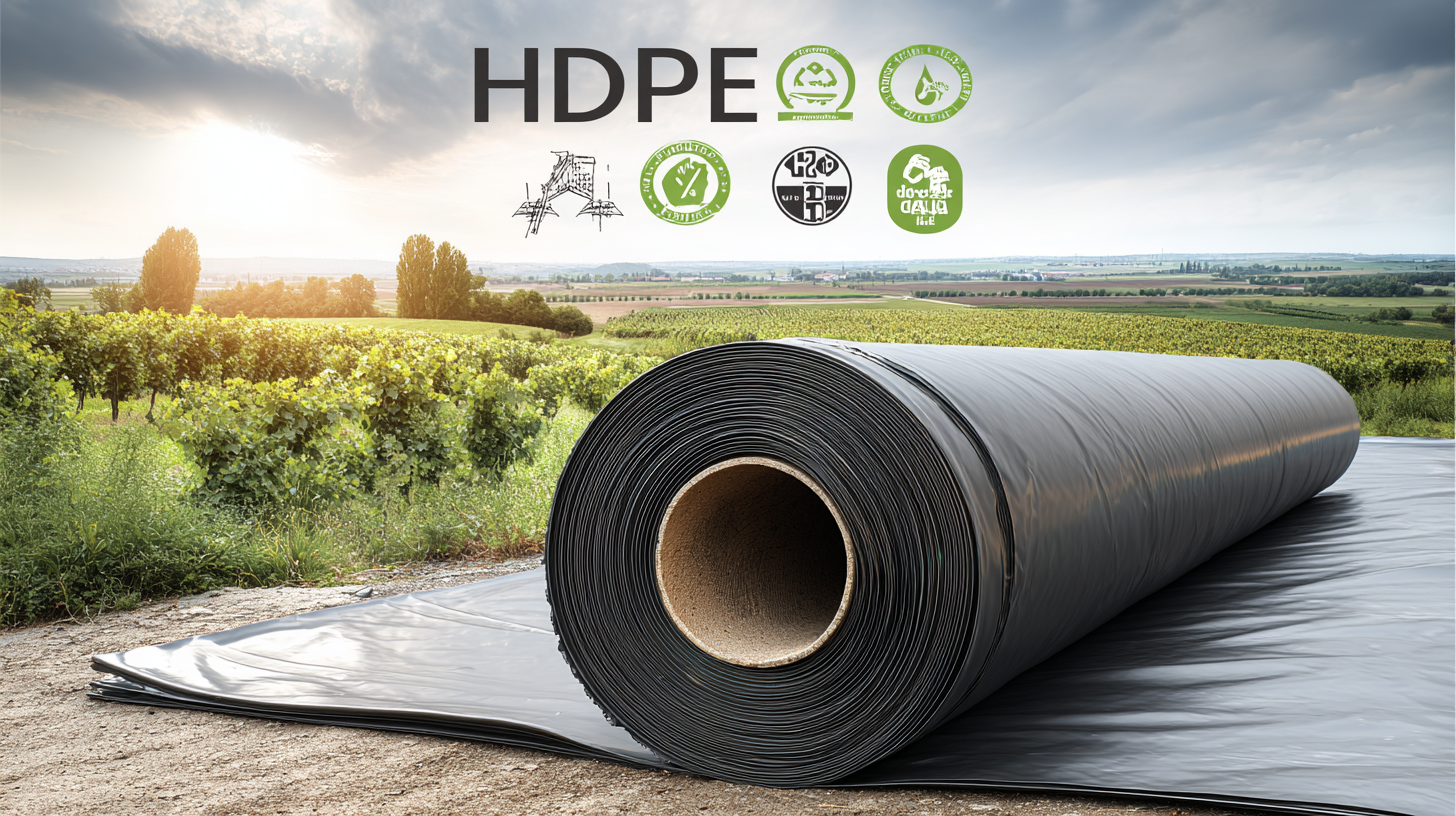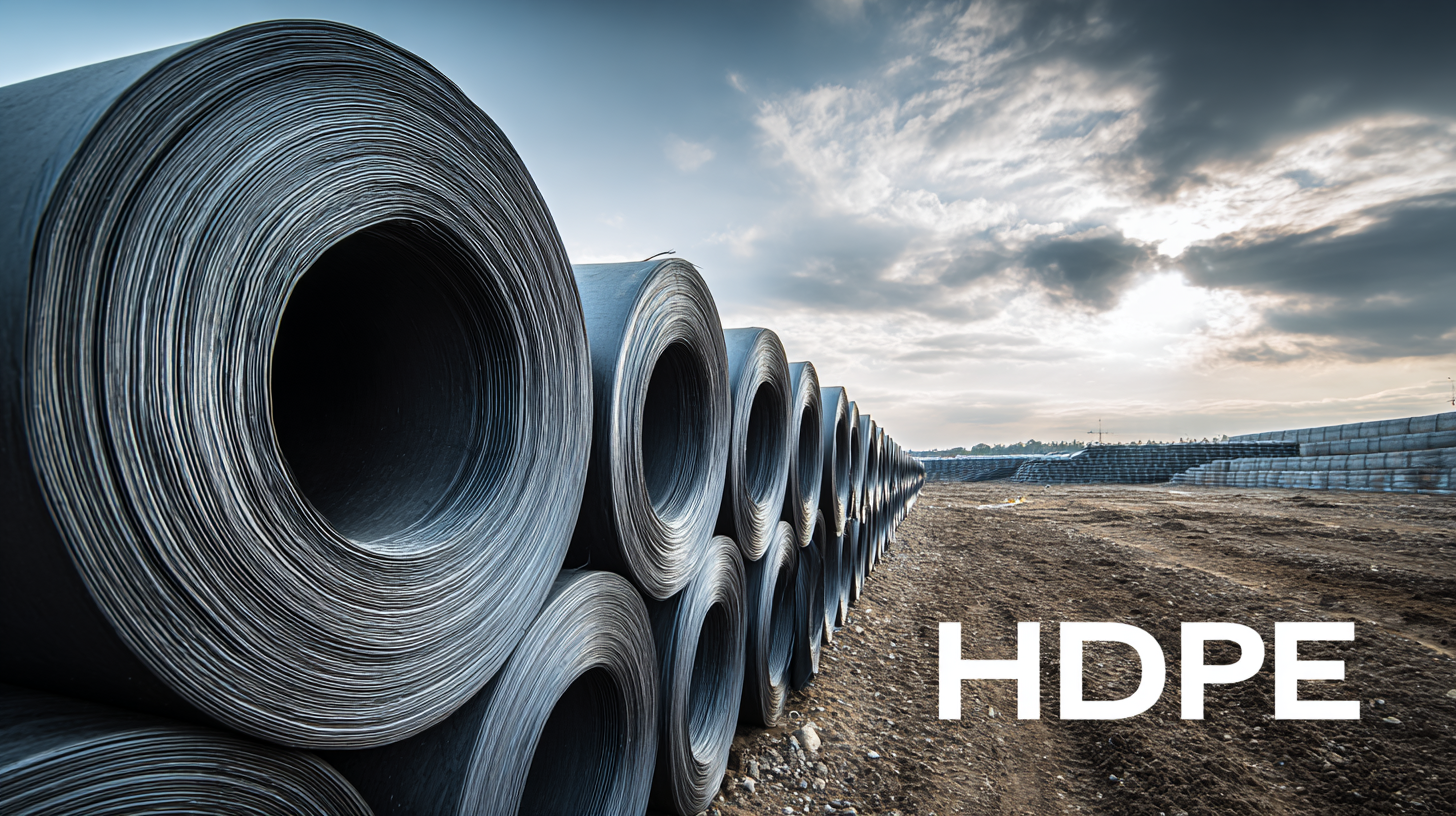Inquiry
Form loading...
- Phone
- E-mail
In the realm of modern environmental applications, the significance of HDPE geomembranes cannot be overstated. These robust synthetic liners, often referred to as "Geomembrana in HDPE," offer unparalleled impermeability and durability, essential for a range of uses including waste containment, water conservation, and soil stabilization. According to a report by the Global Geomembrane Market, the demand for HDPE geomembranes is anticipated to grow at a CAGR of 10.3%, driven by heightened awareness of environmental protection and regulations in various industries. Furthermore, the versatility of HDPE geomembranes makes them ideal for landfill liners and mining applications, ensuring the effective management of hazardous materials and resources. As environmental challenges continue to escalate, understanding the importance of HDPE geomembranes becomes crucial for sustainable development and pollution prevention strategies.

In modern waste management solutions, HDPE geomembranes play a critical role in enhancing the efficiency and sustainability of environmental practices. These high-density polyethylene liners are specifically designed to minimize permeability, making them ideal for applications such as landfill covers and containment basins. According to a study by the Environmental Protection Agency, improper waste management can lead to significant groundwater contamination. By employing HDPE geomembranes, facilities can reduce leakage rates by over 90%, effectively protecting surrounding ecosystems.
Moreover, the global geomembrane market has been growing steadily, with reports indicating a projected CAGR of over 12% from 2021 to 2028. This growth is largely driven by the increasing need for sustainable waste disposal solutions and heightened environmental regulations. HDPE geomembranes not only prevent the migration of hazardous waste but also provide a robust barrier against leachate, ensuring that communities remain safeguarded from potential environmental hazards. The durability and chemical resistance of HDPE products further enhance their suitability for extreme conditions, making them indispensable in modern waste management strategies.
HDPE geomembranes are increasingly recognized for their critical role in environmental protection projects. With a high-density polyethylene composition, these geomembranes are impermeable and provide robust barriers for liquids, making them ideal for applications such as landfill liners, wastewater treatment facilities, and containment systems for hazardous materials. According to a report from the Plastic Industry Association, the global geomembrane market is projected to reach approximately $4.4 billion by 2025, driven by the growing need for landfill containment and groundwater protection.

The durability and chemical resistance of HDPE geomembranes make them particularly valuable in environmental applications. Studies have shown that HDPE geomembranes can withstand a variety of environmental stresses, including UV exposure and temperature fluctuations, for upwards of 50 years. In fact, the Environmental Protection Agency (EPA) has indicated that effective use of geomembranes in landfill projects can significantly reduce the risk of leachate contaminating surrounding soil and water sources, a major concern for public health and ecosystem integrity. As regulatory pressures intensify, the adoption of HDPE geomembranes is set to play a pivotal role in promoting sustainable waste management practices across various sectors.
High-Density Polyethylene (HDPE) geomembranes play a crucial role in enhancing the effectiveness of landfill liners, providing a robust barrier against potential contaminants. One of the key benefits of using HDPE geomembranes lies in their superior impermeability, which prevents the leaching of harmful substances into the surrounding soil and groundwater. This is particularly important in modern environmental applications where protecting natural resources is paramount. The durability of HDPE materials also ensures a longer lifespan for landfill liners, minimizing the need for frequent replacements and reducing overall costs.
Another significant advantage of HDPE geomembranes is their resistance to various environmental stressors, such as UV radiation and chemical exposure. This makes them an ideal choice for diverse applications, including industrial waste containment and municipal solid waste management. Furthermore, the ease of installation and flexibility of HDPE geomembranes enable efficient adaptation to various landfill designs, ensuring optimal performance. As sustainability becomes increasingly important, the role of HDPE geomembranes in preventing leakage and preserving the environment will continue to be vital in waste management strategies.
HDPE geomembranes play a crucial role in modern water conservation efforts, thanks to their superior impermeability and durability. According to a report by the Geosynthetic Institute, HDPE (High-Density Polyethylene) geomembranes can offer permeability levels as low as 1 x 10^-13 cm/s, which makes them an ideal solution for preventing water loss in applications such as landfills, reservoirs, and agricultural irrigation systems. By effectively containing water, these geomembranes help ensure that precious resources are preserved, particularly in arid regions where water scarcity is a pressing issue.
Innovative applications of HDPE geomembranes are expanding into various sectors aimed at enhancing sustainability. For instance, a study published in the Journal of Environmental Management highlights the use of HDPE in constructed wetlands for stormwater management, where they serve as linings to prevent contaminants from leaching into groundwater. Additionally, their lightweight yet robust nature makes them suitable for use in rainwater harvesting systems, further aiding efforts to collect and utilize rainwater efficiently. As we continue to address global water challenges, the adoption of HDPE geomembranes will be pivotal in implementing effective conservation strategies across different environments.
| Application Area | Importance | Innovative Uses | Environmental Benefits |
|---|---|---|---|
| Landfills | Prevent groundwater contamination | Liner systems for waste containment | Protects ecosystems, reduces pollution |
| Water Reservoirs | Minimize evaporation loss | Flexible membrane covers | Conserves water resources |
| Agricultural Use | Irrigation efficiency | Ditch liners and ponds | Enhances crop yield, reduces water usage |
| Mining Operations | Containment of waste materials | Tailings storage facilities | Protects groundwater from contamination |
| Stormwater Management | Reduces runoff and erosion | Permeable barrier systems | Enhances water quality, supports urban planning |
Environmental regulations play a critical role in shaping the use of HDPE geomembranes across various industries. As concerns about soil and water contamination grow, regulatory bodies have implemented stringent guidelines to ensure the responsible management of hazardous materials. HDPE geomembranes, renowned for their impermeability and chemical resistance, have gained prominence as a crucial tool in environmental protection strategies. These barriers not only prevent leachate escape from waste disposal sites but also safeguard groundwater resources, making them indispensable in landfill applications.

Moreover, standards such as ASTM and ISO provide frameworks that govern the selection, installation, and performance evaluation of HDPE geomembranes. Compliance with these standards is vital for projects involving containment systems, wastewater treatment, and mining operations. By adhering to these regulations, companies can mitigate potential environmental impacts while simultaneously enhancing their sustainability profiles. As industries navigate the complexities of environmental compliance, the significance of HDPE geomembranes as a reliable solution continues to grow, reinforcing their role in modern environmental management practices.
